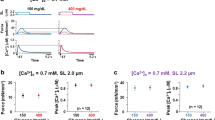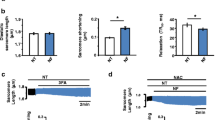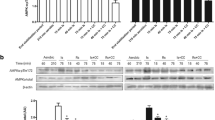Summary
The effect of severe reduction of cytosolic adenine nucleotide (AdN) pool and [ATP]/[ADP] ratio (by 2-deoxyglucose treatment) on functional and metabolic responses of isovolumic rat heart to increased energy demand induced by coronary flow (CF) rise and isoproterenol (Iso) addition has been investigated. AdN-depleted hearts had reduced phosphocreatine (PCr, by 80%), ATP (by 75%), [ATP]/[ADP] (24 times) and pressure-rate product (PRP, by 60%). An elevation of CF was followed by the increase in PRP in control and AdN-depleted hearts by 40–45% with unchanged metabolic parameters. At increased CF, Iso caused a further rise in PRP in both groups due to elevation of heart rate; however maximal levels of PRP in the AdN-depleted group still remained lower than that of control (by 40%). Only in control experiments was Iso addition accompanied by an increase in the difference between left-vetricular end- and minimal diastolic pressure, cytosolic [Pi] and [ADP], and some decrease in PCr and [ATP]/[ADP]. These data imply that severely reduced cytosolic [ATP]/[ADP] does not prevent acceleration of Ca2+ turnover by Iso in cardiomyocytes, it but restricts maximal force development affecting the myofibrils.
Similar content being viewed by others
References
Allen DG, Orchard CH (1987) Myocardial contractile function during ischemia and hypoxia. Circ Res 60:153–168
Bittl JA, Balschi JA, Ingwall JS (1987) Effect of norepinephrine infusion on myocardial high energy phosphate content and turnover in the living heart. J Clin Invest 79:1852–1859
Bunger R, Soboll S (1986) Cytosolic adenylates and adenosine release in perfused working heart. Eur J Biochem 159:203–213
Das AM, Harris DA (1990) Control of myocardial ATP synthase in heart cells: inactive to active transitions caused by beating or positive inotropic agents. Cardiovasc Res 24:411–417
Denton RM, McCormack JG (1980) On the role of the calcium transport cycle in heart and other mammalian mitochondria. FEBS Lett 119:1–8
Eggleton P, Elsden SL, Gough N (1943) The estimation of phosphocreatine and diacetyl. Biochem J 337:526–529
Geisbuhler T, Altschuld RA, Trewyn RW, Anzel AZ, Lamka K, Brierley GP (1984) Adenine nucleotide metabolism and compartmentalization in isolated adult rat heart cells. Circ Res 54:536–546
Griese M, Perlitz V, Jungling E, Kammermeier H (1988) Myocardial performance and free energy of ATP hydrolysis in isolated rat hearts during graded hypoxia, reoxygenation and high K+ perfusion. J Mol Cell Cardiol 20:1189–1201
Hansford RG (1985) Relation between mitochondrial calcium transport and control of energy metabolism. Rev Physiol Biochem Pharmacol 102:1–62
Hoerter JA, Lauer C, Vassort G, Gueron M (1988) Sustained function of normoxic hearts depleted in ATP and phosphocreatine: a31P-NMR study (1988) Am J Physiol 255:C192-C201
Katz A (1979) Role of contractile proteins and sarcoplasmic reticulum in response of heart to catecholamines. Adv Cyc Nuc Res 11:303–343
Katz LA, Koretsky AP, Balaban RS (1988) Activation of dehydrogenase activity and cardiac respiration: a31P-NMR study. Am J Physiol 255:H185–188
Kentish JC (1986) The effect of inorganic phosphate and creatine phosphate on force production in skinned muscles from rat ventricle. J Physiol 370:585–604
Kupriyanov VV, Lakomkin VL, Kapelko VI, Saks VA (1990) Myoplasmic phosphate metabolites in the integration of oxidative phosphorylation and contractile function in the myocardium. Biomed Sci 1:113–121
Kupriyanov VV, Lakomkin VL, Kapelko VI, Steinschneider AY, Ruuge EK, Saks VA (1987) Dissociation of adenosine triphosphate level and contractile function in isovolumic hearts perfused with 2-deoxyglucose. J Mol Cell Cardiol 19:729–740
Kupriyanov VV, Lakomkin VL, Korchazhkina OV, Stepanov VA, Steinschneider AY, Kapelko VI (1991) Cardiac contractile function, oxygen consumption rate and cytosolic phosphates during inhibition of electron flux by amytal—a31P-NMR study. Biochim Biophys Acta 1058:386–399
Kupriyanov VV, Lakomkin VL, Steinschneider AY, Veksler VI, Korchazhkina OV, Kapelko VI, Saks VA (1991) Adrenergic stimulation of the heart during inhibition of phosphocreatine and adenylate pathways of energy transfer. Physiol J (Russ) in press
Kupriyanov VV, Steinschneider AY, Ruuge EK, Kapelko VI, Zueva MY, Lakomkin VL, Smirnov VN, Saks VA (1984) Regulation of energy flux through the creatine kinase reaction in vitro and in perfused rat heart. Biochim Biophys Acta 805:319–331
LaNoue KF, Bryla J, Williamson JR (1972) Feedback interaction in the control of citric acid cycle activity in rat heart mitochondria. J Biol Chem 247:667–674
Lawson JWR, Veech RL (1979) Effects of pH and free Mg2+ on the Keq of the creatine kinase reaction and other phosphate transfer reactions. J Biol Chem 254:6528–6537
Matthews PM, Williams RA, Seymour A-M, Schwartz A, Dube G, Gadian DG, Radda GK (1982) A31P-NMR study of some metabolic and functional effects of the inotropic agents epinephrine and ouabain and ionophore RO2-2985 (X537A) in the isolated, perfused rat heart. Biochim Biophys Acta 720:163–171
Mekhfi H, Ventura-Clapier R (1988) Dependence upon high energy phosphates of the effects of inorganic phosphate on contractile properties in chemically skinned rat cardiac fibers. Pflügers Arch 411:378–385
McCormack JG, England PJ (1983) Ruthenium red inhibits the activation of pyruvate dehydrogenase caused by positive inotropic agents in the perfused rat heart. Biochem J 214:581–585
Schoenberg M, Eisenberg E (1987) ADP binding to myosin cross-bridges and its effect on crossbridge detachment rate constants. J Gen Physiol 89:905–920
Sleep J, Glyn H (1986) Inhibition of myofibrillar and actomyosin subfragment 1 adenosine triphosphatase by adenosine 5′-diphosphate, pyrophosphate, and adenylyl-5′-yl imidodiphosphate. Biochemistry 25:1149–1154
Williamson JR, Schaffer SW, Scarpa A, Safer B (1974) Investigation of calcium cycle in perfused rat and frog hearts. In: Dhalla NS (ed) Recent Advances in Studies on Cardiac Structure and Metabolism vol 4. University Park Press, Baltimore, pp 375–392
Author information
Authors and Affiliations
Rights and permissions
About this article
Cite this article
Kupriyanov, V.V., Korchazhkina, O.V., Lakomkin, V.L. et al. Adrenergic stimulation of rat hearts with severely reduced cytosolic adenine nucleotide pool and [ATP]/[ADP] ratio. Basic Res Cardiol 87, 139–147 (1992). https://doi.org/10.1007/BF00801961
Received:
Accepted:
Issue Date:
DOI: https://doi.org/10.1007/BF00801961




